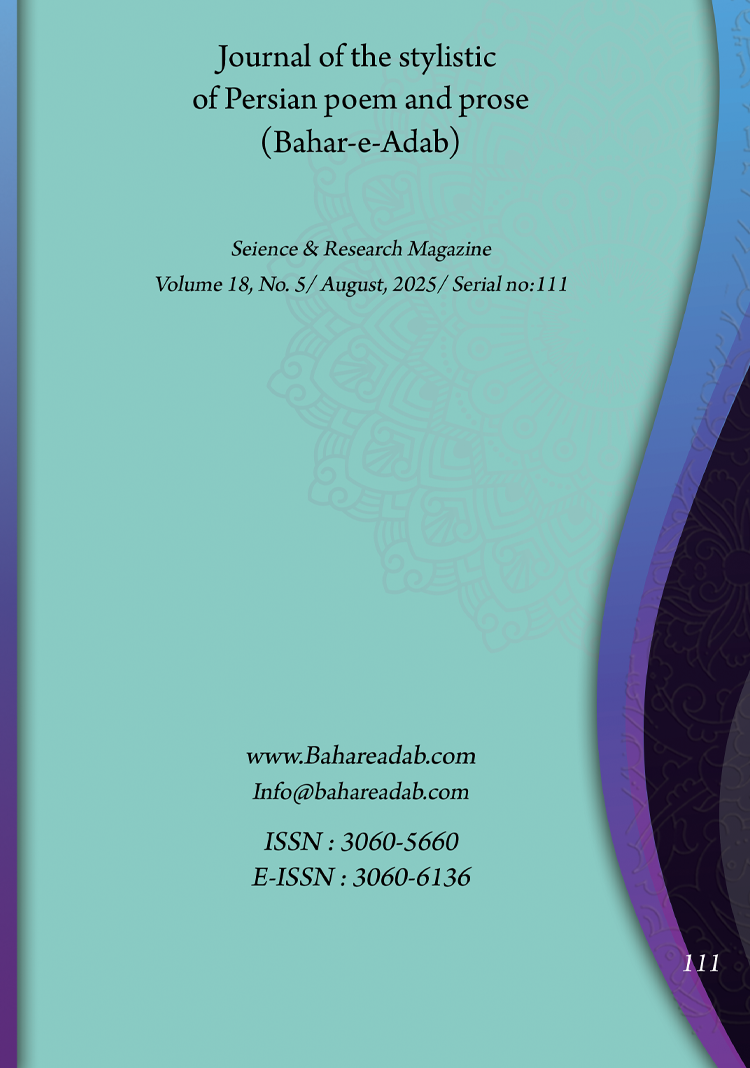- Count View : 11
- آدرس کوتاه شده مقاله: https://bahareadab.com/article_id/1858
- کد doi مقاله: Doi: 10.22034/bahareadab.2025 .18 .7894
Journal of the stylistic of Persian poem and prose
volume Number 18،
number In Volume 5،
،
issue Number 111
Study of Mind and Language in the Ghazal of Maulana Abdullah Rawanbad (Famous for Saadi of Balochistan)
Mojib Alrahman Dehani (Author in Charge), Abbas Nikbakht
Abstract
BACKGROUND AND OBJECTIVES: Poetry is a mixture of mind, meaning, and imaginative forms. The poet combines his intellectual principles with imagination and expresses it in the language of Sari and in the form of poetry. The connection and bond between language and thought is inseparable. The poet"s language is influenced by his thoughts and views; however simple and unadulterated his thoughts may be, his language will also be explicit and far from artificial and burdensome interpretations and concepts. Maulana Abdullah Rawanbad, pen name "Rawanbad" and known as "Maulvi Rawanbad, Saadi of Balochistan", is a famous and famous Baloch poet whose Persian speaking is also noteworthy. The elegance of his poetry, the beauty of his expression, his lofty and gentle nature, and his exquisite, beautiful, and charming poems have always been praised and paid attention to by experts in Persian and Baloch literature.
METHODOLOGY: The research method in this study is descriptive-analytical based on library studies and documentary methods and taking notes on Rumi Ravanbad"s ghazals.
FINDINGS: Ravanbad"s ghazals have richer music and have compensated for the shortcomings of rhyme. Also, from a literary point of view, he has used many similes and metaphors that strengthen the characteristics of the Iraqi style in his poetry. The element of repetition of words and creating proportion between words also has an important place in his ghazal. Intellectually, he has written mostly love poems and described the beloved, the sorrow of separation and separation, and lamentation over a friend. His other themes include the praise of God and the Prophet, Qalandari themes, and rarely mystical. The important point of his poems is the influence of the poetry of Hafez and Saadi, such that he is known in the literature and local society of Balochistan as Saadi of Balochistan.
CONCLUSION: In this study, with the aim of understanding the literary style and types of ghazal music of Abdullah Ravanbad, we examined his poems and, by mentioning examples of the types of applied meters, radif and rhyme, verbal and spiritual arrangements, and his intellectual foundations, we came to the conclusion that Ravanbad did not vary in choosing meters and only used three different bahrs al-arkan and three bahrs tawfiq al-arkan and used about twenty of these meters to compose ghazals, the highest frequency of which is the bahr mujtazit mutsat-an-makhbun mahfoof and the mahfoof mutsat-an-akhreb makfoof mahfoof, which he used to express the sadness and sorrow of separation and lamentation for a friend, and the other bahrs have lower frequencies. In terms of the use of radif, the frequency of the present radif in his ghazal is higher and constitutes half of the radifs, but the rhymes of his poems do not have any special characteristics, and in cases where the rhyme is consonant with words from the verse, the music is more pleasant to the ear.
Keyword
Mind
, Language
, Ghazal
, Abdullah Ravanbad. Stylistic Features
- Sabetzadeh, Mansoureh (2019) “A Comparative Study of Prosodic Features of the Ghazals of Saadi, Rumi, and Hafez”, Specialized Quarterly Journal of Persian Poetry and Prose Stylistics, Year 12, Issue 3, 45 consecutive pages, 41-65.
- Hafez, Shams al-Din Muhammad (1391) Divan of Poems, Tehran: Fekr Rooz.
- Razi, Shams al-Din Muhammad ibn Qais (1360) Al-Mu'jam fi Ma'ayir Sha'ar al-Ajam, edited by Modarres Razavi, Tehran: Zavar
- Hafez, Shams al-Din Muhammad (1391) Divan of Poems, Tehran: Fekr Rooz.
- Ravanbad, Abdullah (1383) Divan of Ravanbad, Introduction, Editing and Commentaries by Abdul Ghafoor Jahandideh, Zahedan: Bam Dunya.
- Ravanbad, Riyatullah (1388) The Great Jurist, Saadi of Balochistan Allama Maulana Abdullah Ravanbad, Nedaye Islam, Year 10, Vol. 38, pp. 16-12.
- Zarrinkoob, Abdul Hossein (1363) A Journey in Persian Poetry, Tehran: Navin.
- Saadi, Mosleh al-Din (2006) Saadi's Compendium, Tehran: Hermes.
- Shah Hosseini, Naser al-Din (1976) Analysis of Naser Khosrow's Odes and Their Evaluation by Persian Prosody Criteria, Publication of the Faculty of Literature and Humanities, University of Tehran, Vol. 93-94, pp. 97-117.
- Shafi'i Kadkani, Mohammad Reza (1991) Music of Poetry, Vol. 3, Tehran: Aghah. 10. ----------------------(2007) Imagination in Persian Poetry, Tehran: Nil.
- Shamisa, Sirous (2007) Prosody Culture, Vol. 3, Tehran: Ferdows.
- Safavi, Kourosh (1994) From Linguistics to Literature, Tehran: Cheshme.
- Tusi, Khajeh Nasir (1989) The Standard of Poetry, edited by Jalil Tajlil, Tehran: Jami and Nahid.
- Kurd, Noorallah (2007) A Note on Contemporary Poets, Tehran: Pouyan Farzanegan. Karami, Mohammad Hossein (2001) Essays and Rhymes in Persian Poetry, Shiraz: Shiraz University.
- Mahyar, Abbas (2000) Essays in Persian, Vol. 5, Tehran: Qatra.
- Modarresi, Hossein (2005) A Practical Dictionary of Persian Poetry Metrics, Tehran: Samat.
- Rumi, Jalal al-Din Mohammad (2005) Divan Kabir Shams, Tehran: Talaiyeh.
- Natel Khanlari, Parviz (2004) Weights of Persian Poetry, Vol. 6, Tehran: Toos.
- --------------(2001) Haftad Sokhan, Tehran: Toos.
- Vahidian Kamyar, Taghi (1988), Study of the Origin of Persian Poetry Meter, Mashhad: Astan Quds Razavi.

